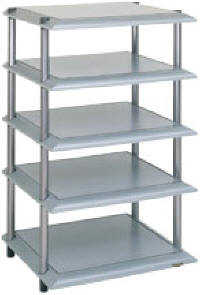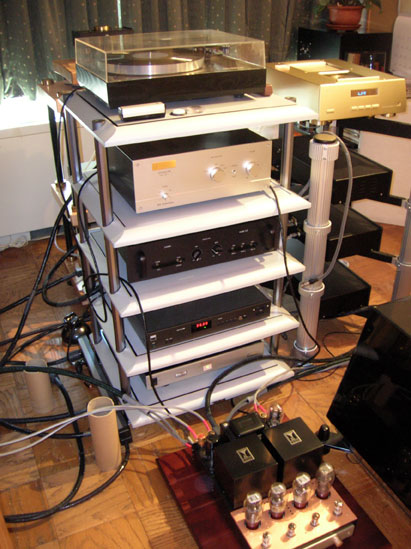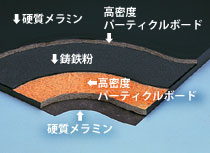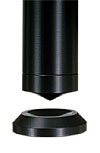You are reading the older HTML site
Positive Feedback
ISSUE
22
taoc
AS Component Rack and Accessories
as reviewed by Marshall Nack

|
MARSHALL NACK'S SYSTEM
LOUDSPEAKERS
ELECTRONICS
SOURCES
CABLES
ACCESSORIES
|
"TAOC? Who's that?"
Potent bass; smooth frequency response; a tonal balance so well apportioned it made me suspect some form of equalization might be involved—powerful stuff, huh? These were outstanding in the rooms of a couple of exhibitors at HE2005 East I'm well acquainted with. Curious, then, that when I looked around the gear looked mostly familiar. It took a second glance to notice both exhibitors were using new component racks made by TAOC. "Made by who?" I inquired. "How do you pronounce that?" I jotted down: "Well-made and functional," and little else—the TAOC AS racks tend to blend in inconspicuously.
On the following show days I made the rounds. Racks were on my mind—I was in the market for a new generation product, so I made a point to spend time with Mike Latvis, the designer/manufacturer of the highly regarded HRS rack system. I even setup a tentative post-show meeting to audition some of his products. Separately, I was also considering the finite elemente line. These two, plus the Harmonix Royal Stage, represent the cutting edge in rack systems, in my opinion.
But I liked what I was hearing in those rooms with the TAOC. That, plus the firmly positive accounting given by the two exhibitors, decided it for me.
Trust Your First Impression
That first impression at HE2005E was indeed prescient. In short order, I heard just what I imagined and hoped I would hear. (This is generally not a good habit to indulge in. Back when I was involved in photography, I came up with a motto explicitly forbidding such advance fantasy. I made it one of the Ten Commandments that I scribed on museum board and posted in my darkroom: "Thou Shalt Not Fantasize Pre-Positivo." It means: don't fantasize about images from a shoot that are still undeveloped on the film. Save your enthusiasm until you at least have the contact sheet.) [Your editor, long-time in photography and possessor of my own darkroom, agrees heartily. Good proverb.]
Before the swap, with my analog front-end on my reference Polycrystal rack, I gave the Benjamin Britten Sinfonietta a spin (Lyrita SRCS.111, LP). This average sounding Lyrita from 1982 (average for a Lyrita means at least "Class A" in LP-land) is difficult material. I wasn't bowled over, even though I was running it through the Audio Note Ongaku M77 pre-amp with its built-in MM phono and separate ANJ step-up device, the best phono amplification I've ever encountered. The piece is all about dense section counterpoint, but I couldn't resolve individual lines. How can you appreciate the composition when it all tended to congeal in a center-of-stage mass? And consider that Polycrystal's strong suit is its uncanny soundstaging and imaging, its ability to float a highly dimensional and discretely layered stage, albeit at the cost of being somewhat weightless and thin.
The view changed considerably with the ANJ gear moved onto a TAOC AS rack. Imaging was about as good, but was now spread out over a wider stage, opening up the soundscape and effectively surpassing the Polycrystal at its strong point. Instrumental lines segregated—the blurring and blending evaporated—as the TAOC laid out discrete, unwavering section lines upon a granite-like foundation. And, lo, there they were: the powerful and dynamic low-end; the smooth frequency response; the near-perfect allotments of bass, midrange and treble. Plus, there was an unmistakable body attached to those anorexic cutouts, they became substantial. Talk about weight—the TAOC rack will give it to ya in spades! This time around, the promises were fulfilled—I couldn't get rid of the silly grin across my face.
To get to this point, however, I had to do some re-balancing because tonality took a decided shift downward. This was easily accomplished by lowering the output level and cutoff frequency of the Kharma Ce-Sb powered sub and removing one or two Golden Sound Magic Rings. Out went the Shunyata Hydra power conditioner and the Reimyo ALS-777 conditioner, which I had piggybacked for front-end duties, and both of which boost the low-end. I did my listening with zero power conditioning.
About power conditioners
Permit me a digression here on the subject of power conditioners—it's high time somebody spilled the beans. We really shouldn't call that box we put between the AC wall outlet and our components a "power conditioner," because, to be honest, we expect them to do all sorts of things unrelated to AC gremlins.
Myself, I use the Hydra principally when I need to boost the low-end. (I'm talking about the original iteration of the Hydra here—I haven't tried the new version.) The Hydra's vaunted noise reduction and response smoothing are secondary benefits, and most often, I don't need them. Plus, I'm not crazy about what it does to the treble or the sense of immediacy. But when I need more weight, this box is most effective. Likewise for the Reimyo ALS-777, which imposes a similar tonal shift, and has secondary benefits of relaxing and tuning. The Accuphase PS-500 shifts the tonal palette in the reverse direction, while purifying better than anything out there, but impacts dynamics slightly.
I value power conditioners mostly for what they do in the realm of equalization or tone control. These days, good components handle AC issues on their own. What I really want in a "power conditioner" is a constant quality AC line 24/7/365, so that when I play my system in the morning it sounds no different from the evening. I ran these thoughts by an importer of some big-name audio brands. "That's true," he said, "and we use wires to do the same thing. Maybe we should just go back to tone controls on the pre-amp." [Former PFO contributor Ray Chowkwanyun was a firm advocate of quality tone controls/graphic equalization in fine audio. – Ye Olde Editor] Sounds like a V-good idea to me. While we're at it, why not take all those extras, like QRT, which is becoming ubiquitous in conditioners, and either make them optional plug-ins, or have a switch to defeat them?
Back to the rack
So, this is a happy thing—I love to take tweaks out. Generally speaking, if the gear is up to it and well chosen, a system will always sound better without tweaks. Some might argue that the rack itself is a tweak. Yes, I suppose one could say that, to the extent that it imposes a change. To my mind, the difference between the TAOC and tweaks is that it doesn't attempt to identify and somehow tune or nullify source problems. It is pure engineering, an uncolored ingredient that just does its job well and passes along the exact quality of your source.

TAOC and Solid Tech match-up
So far, we've compared a rigid, high mass, inert rack without any damping (the Polycrystal), to a lighter, less inert one with damping provided by cast-iron powder (the TAOC).
The competition got tougher when I switched to CD. I chose Symphony No. 4 from Schumann Revealed (Archiv 289 457 352-2), the eye-opening account delivered by John Eliot Gardiner with his period instrument Orchestre Révolutionnaire et Romantique and the Monteverdi Choir. This is Schumann like you've never heard him before. The performance is loaded with fresh insights and drama. Sound is rather good, too. I use Gardiner's agile, powerful intro to the second movement for demonstration purposes. It has great momentum and flows easily, while avoiding excessive control.
This was a closer match-up as the digital front-end sits on last year's favorite rack, the Solid Tech Rack of Silence (ROS). In addition, I use Harmonix RF-66ZX footers under the components on the ROS. This represents my maxed out, top-level tweak support, arrived at after years of shopping around. With the digital setup this way, there's no edge in those violins at all. Dynamics, timbre, staging—I've lived with this arrangement for a year and it's really great.
Murk Begone
Just by moving the DAC from the ROS (plus RF-66ZX) onto the TAOC without any footers, there it was again—everything was firmer, more solidly placed. Dynamics kicked in forcefully, adding to the drama, and there's that evenness of response and tone quality—this is pure sound. The stage is noticeably wider again, as wide as it gets in my room. The damping from the cast-iron in the TAOC means judicious control of resonance and vibration, which translates into stunning, realistic soundstage resolution. Whatever murkiness or lumbering fat had been present became taut—not shriveled up and shrunk, because images are just as big—simply, that the fat has become firm. And the mass comprising the image moves in unison. Not only do you know who is singing at any given moment, you can clearly hear each word. Percussion instruments pop out with startling immediacy and transient power.
While the ROS with Harmonix footers has even more weight, it is also softer, tuned so it sounds more acoustic. The soundstage is more distant. The treble is more noticeable and thinner, its quality has changed—we've lost the evenness of response.
So which one is better? They do very different things. They're each at the top of what's available in component support, but I think the strengths of the TAOC AS rack on its own will be as appealing to folks who value accuracy as the ROS and Harmonix combo are to those into warmth and acoustic tuning. (Figure, that's one TAOC AS = ROS plus four sets of Harmonix footers, for about double the cost). Now let's see what happens when you give it the benefit of those high quality footers. Which one is better? Slipping some RF-66ZX under the digital gear on the TAOC brings out the tuning effects: the timbre becomes more acoustic; it's more holistic, the performers are occupying one space; it's like somebody applied an airbrush. Instrumental sections are more discrete in spite of the fact that the soundstage has moved back from the speaker plane and its width has shrunk. And tonal balance has dropped some more. You could say the RF-66ZX builds upon the strong foundation laid by the TAOC, adding tuning effects, relaxing the sound, adding even more weight. You might also make a case that they compromise the strict neutrality of the TAOC rack.
After all the testing, what it boils down to is 1) the TAOC, or 2) the TAOC. The AS rack solo is nonpareil for a totally neutral, SOTA voicing. With added Harmonix footers, it's similar to the ROS/Harmonix, but stronger. If you like these effects, this is the way to go, no contest. Which variation is for you depends on what the system needs and your personal taste. Do you want your cuppa-jo straight up or with a scoop or two of sweetener and a little more weight? When I was running a low-wattage SET rig, I definitely preferred the TAOC straight up. Later, when switching to my reference high-power Kharma speaker-based system, I wanted to loosen things up and add warmth and weight—that's when the Harmonix footers went back in. I also liked the coherency ER Audio Space Harmonizer boards brought to the digital front-end.
Cast-Iron Powder
TAOC products are distinctive in their use of graded cast iron and cast-iron powder—this is the "active ingredient," so to speak. Most audiophiles know about pouring lead shot or sand into the hollow steel tubing of their shelving or into boxes placed under components, but I've never come across the use of cast-iron powder before. All three fillings employ damping to control vibration and resonance, and all impart a tonal shift downward. But with the first two, the presentation becomes dull and lifeless; the TAOC cast-iron actually adds life and naturalism, provided it is not over-applied.
I tell you, I'm not missing my power conditioning. There's something about TAOC's application of cast iron that does things I hear with good conditioners. The background is dead quiet. Low-level details abound. Frequency response is definitely more linear. When's the last time you heard a double bass solo that didn't give you a mottled impression, some notes jumping forward and others receding? (This is a common problem. The room is a big factor in lumpy and uneven bass, but not the only one. If you've ever tried to fix it, good luck to ya—you know how difficult it is.)
Earlier, before the TAOC came, I was hearing a hump in the mid-bass and I was all set to attribute this to the speakers under review—that would have been an egregious error.
Bingo! I just had one of those "aha" insights. For a while now, I've been remarking how good analog has been sounding, how the gap between it and digital has widened. I couldn't understand why—I spend no time tweaking it—all my efforts go towards improving the digital or the downstream components. Now it dawns on me; the last two pre-amps I've used had built-in phono stages—and both sat on a TAOC shelf, while my digital has remained on the ROS! Now that I've got extra TAOC shelf space to hold the transport and DAC (yes, I've gone all out TAOC for my racks), I have to say that gap has narrowed. And I've got a lot of footers I won't need any more.
Hardware
When I learned that TAOC is a member of the Toyota group of companies it instantly established high credibility. I figured, here's a commercially successful Japanese powerhouse who obviously knows what they're doing, who could throw huge R&D resources into their products. The TAOC division of Toyota is the largest producer of cast-iron automobile parts in Japan, and unbeknownst to us, they've been in the audiophile accessory business since 1983. They've just recently acquired a US distributor. What's surprising is that a large conglomerate would bother with such a small consumer marketplace.

As for the AS Series Rack, the instruction booklet may be in Japanese, but assembly was easy. Shelves are constructed of five constrained layers. The core layer is cast-iron powder. This is sandwiched between high-density particleboard, then overlaid and finished with hard melamine on both sides. Visually, ain't nothing special to note about them. Black on one side, light grey on the verso, average weight, they appear much like other audio-grade shelving. Each shelf sits inside an aluminum die-cast frame with a pin at each corner—the shelf rides on four pinpoints, which are adjustable for leveling purposes.
 The frame uprights are faceted, die-cast aluminum
poles, delivered in sections that screw together. Each junction between pole and
frame is fitted with a cast-iron spacer—or so I thought. Turns out the spacers
are only on the underside of the frame, leaving the aluminum pole on top in
direct contact with the aluminum frame (except for the top rung, which has
spacers on both sides). Huh? That breaks one of my golden rules: where
possible, avoid metal-to-metal contacts. Wouldn't it be better to have a spacer
both under and over the frame? Also, the frames sing a little when a knuckle rap
is applied. These few design details I felt could have been done better. Then
again, the TAOC rack sounds so good maybe they were considered. I like the fact
that after assembly the rack stays rigid. Periodically, you can test the
tightness of the frame with the provided Allen wrench on the four top screws of
the uprights. I did, and they were not—loose, that is.
The frame uprights are faceted, die-cast aluminum
poles, delivered in sections that screw together. Each junction between pole and
frame is fitted with a cast-iron spacer—or so I thought. Turns out the spacers
are only on the underside of the frame, leaving the aluminum pole on top in
direct contact with the aluminum frame (except for the top rung, which has
spacers on both sides). Huh? That breaks one of my golden rules: where
possible, avoid metal-to-metal contacts. Wouldn't it be better to have a spacer
both under and over the frame? Also, the frames sing a little when a knuckle rap
is applied. These few design details I felt could have been done better. Then
again, the TAOC rack sounds so good maybe they were considered. I like the fact
that after assembly the rack stays rigid. Periodically, you can test the
tightness of the frame with the provided Allen wrench on the four top screws of
the uprights. I did, and they were not—loose, that is.
The SP-500 Spike & Plate set (included with the rack) consists of four threaded spikes that screw into the bottom of the uprights. They are more like cones than spikes—their points are gradual and come to a rounded tip. These rest on spike plates. Very well made of graded cast-iron, heavy and finished in matte black, the spikes and plates exude quality and look expensive.
Tweaks
Try this homemade tweak under the shelves: take four copper pennies and attach some sorbothane or other visoelastic compound to one side. Now stick this under the shelf where the four support pins contact the aluminum frame, sorbo up so it sticks to the shelf. This gets rid of some ringing at the shelf/pin interface and aids definition.
SCB-CS60D platforms
TAOC makes stand-alone component platforms that come in various sizes and quality levels. I got the top-of-the-line CS level Sound Creation Boards (SCB). These have five-layer construction like the shelves on the AS rack, but are massive and heavy, about twice as thick (2.5"), and the top and bottom layers are dissimilar material. The intended use is under your component rack, where it would supplant soft carpeting or compensate for a pliable wooden floor.
I didn't try it there, but I did use the SCB as an amp stand—one 24" W x 24" L board supporting both TRON Electric Cantata monoblocks. They replaced the Harmonix TU-888 boards. (Every amp starts out on the TU-888—and usually stays there.) You won't be surprised to know that I found comparable results as with the AS rack. Once again, there's that evenness of frequency response regardless of the volume setting—the same surface quality, the same amount of flesh, the same transient attack throughout the spectrum. Where there was silence there's now the instrument. What I'm saying is the transient is no different in quality from the note's follow through. This is subtle and the way it should be, and also important, key to maintaining credibility. The sound is less soft, diffuse and delicate and not as weighty as with the TU-888.
SCB under Hørnings
I wasn't sure this was going to work. The Hørning Agathon Ultimate speaker is a mid-size floor-stander with a ton of low-end. The SCB platform turned out to be the optimal support for this speaker. Sure, there is a huge amount of energy in the low bass through the low mids. What I like is the life down there, how multiple instruments playing the same frequencies are kept distinct. This is no mean feat and always brings a smile. Maybe it had something to do with the Agathon's floor-firing horn, whose output was now being sopped-up by the SCB, instead of the parquet tiles over my concrete floor. About the only thing I could quibble with here was the reduction in air. Even though treble extension was fine, it was just a little too dry.

SCB under Kharma CRM 3.2s
This seemed like a natural, and I looked forward to trying it out. The 3.2s and their aluminum SDSS stands worked as expected when placed on the SCB platform. Then I put my reference Harmonix RF-999 spike bases in place of the SCB and SDSS aluminum spike plate.
The salutary effects of the RF-999s used alone under the speakers were very different, but about matched by those of the SCB. The SCB gave images definition and brought out subtle details; the massive RF-999s didn't have that but did have flow and dancing ability. The Harmonix footers smoothed image edges and concentrated the sound around the fundamental tone, but the frequency spectrum wasn't as balanced and even. I consider this a draw. It depends on what the presentation needs most. By the way, don't the Kharma 3.2s look great on the TAOC SCB boards?

PTS-F Spike Plate set
Here's another little tweak for you compadrès with Kharma speakers. TAOC PTS-F Spike Plates are over sized, cast-iron plates with dimples to accept spike points, very similar to the Spike Plates in the SP-500 set.
Once again, the outcome was a draw. Lateral substitution for the Harmonix RF-999s resulted in no trade off in terms of weight and body—very good performance for a fraction of the price. Then I put the SCB in place under them. The first time out, the effect went too far—the treble was swallowed up—gone—and all the life was drained from the sound. Same thing when I used the PTS-F under the pre-amp, which was sitting on a TAOC shelf. But then later on, with different gear in place, I re-visited the PTS-F on the SCB and found it fit the bill perfectly (this has become my reference Kharma 3.2 support). These are powerful tweaks—a little goes a long way. Use judiciously.
Conclusion
The TAOC AS Component Rack lived up to my expectations—and then some. It adds body and weight in equal portions across the frequency spectrum and boosts dynamics and definition. This is a powerful tool in the battle for realistic weight and body. Its strategic use of cast-iron easily surpasses sand-filled component platforms, lead shot in your rack's tubing or other forms of mass loading. The TAOC will give you more natural weight and resonance control than any combination of the former could provide. And if you're doing battle with an aggressive treble, this is the Rx.
About the only criticisms I can level at the TAOC AS Rack concerns certain design or construction elements that I thought could have been done better. As far as sound, there isn't a single negative I can come up. Once you've made the necessary adjustments to offset the decrease in treble, everything will be better. When I was running a low-wattage SET rig, there was no contest—I definitely preferred the TAOC AS Series AV Rack on its own to my most tweaked-out component support, the Solid Tech Rack of Silence plus additional Harmonix RF-66ZX footers.
Then, when all the guest linestages and amps had departed and I was left with my cost-effective but admittedly lesser quality, high-power reference, I needed to warm things up, and add even more body, weight and flesh—in general, to fill in the sound—the Harmonix RF-66ZX were re-introduced. In the end, whether with a low-wattage SET rig or a high powered one, adding the TAOC AS rack to the equation put me solidly ahead of where I began. I now play LPs I know well—and they sound like they've morphed into 200gram, 45 RPM, single-sided collector's items.
For the audiophile deep into the pursuit of advanced sound, who is already beyond mid-fi, including mid-fi racks, the next hurdles involve finessing more realism. This happens in small, incremental dollops. At this level, two-thousand-five-hundred greenbacks will get you one or two pieces of wire or maybe a power conditioner. You'd get a bigger bang by placing all your gear on a five-shelf TAOC AS rack. What the TAOC brings to the table far outstrips anything I can think of for its asking price. I would buy it just for the enhanced body and weight alone! Marshall Nack
TAOC
AS series 5 shelf AV Rack, including SP-500: set $2500
SP-500 Spike & Plate set/4: $130
PTS-F Spike Plate set/4: $100
SCB-CS60D platform: $600
Approx 23.5L x 23.5W x 2.5"H
Importer information
Axiss Distribution, Inc.
17800 S. Main St., Suite 109
Gardena, CA 90248
TEL: 310. 329. 0187
email address: [email protected]
web address:
www.axiss-usa.com
